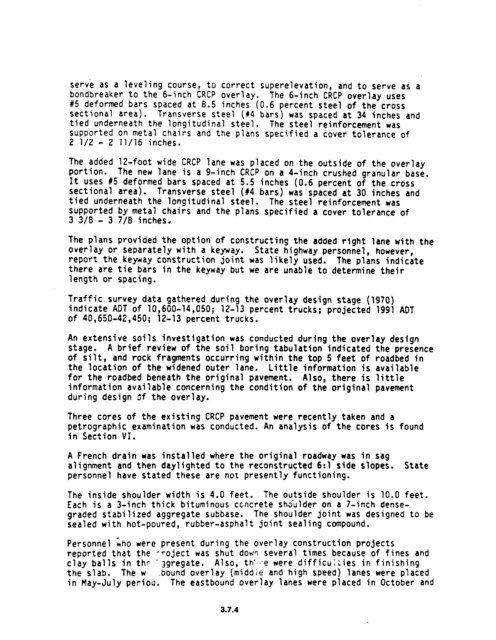chapter 3 rigid pavement - DOT On-Line Publications - Department ...
chapter 3 rigid pavement - DOT On-Line Publications - Department ...
chapter 3 rigid pavement - DOT On-Line Publications - Department ...
You also want an ePaper? Increase the reach of your titles
YUMPU automatically turns print PDFs into web optimized ePapers that Google loves.
serve as a leveling course, to correct superelevation, and to serve as a<br />
bondbreaker to the 6-inch CRCP overlay. The 6-inch CRCP overlay uses<br />
15 deformed bars spaced at 8.5 inches (0.6 percent steel of the cross<br />
sectional area). Transverse steel (#4 bars) was spaced at 34 inches and<br />
tied underneath the longitudinal steel. The steel reinforcement was<br />
supported on metal chairs and the plans specified a cover tolerance of<br />
2 l/2 - 2 11/16 inches.<br />
The added 12-foot wide CRCP lane was placed on the outside of the overlay<br />
portion. The new lane is a g-inch CRCP on a &inch crushed granular base.<br />
It uses #5 deformed bars spaced at 5.5 inches (0.6 percent of the cross<br />
sectional area). Transverse steel (#4 bars) was spaced at 30 inches and<br />
tied underneath the longitudinal steel. The steel reinforcement was<br />
supported by metal chairs and the plans specified a cover tolerance of<br />
3 3/8 - 3 7/8 inches.<br />
The plans provided the option of constructing the added right lane with the<br />
overlay or separately with a keyway. State highway personnel, however,<br />
report the keyway construction joint was likely used. The plans indicate<br />
there are tie bars in the keyway but we are unable to determine their<br />
length or spacing.<br />
Traffic survey data gathered during the overlay design stage (1970)<br />
indicate ADT of 10,600-14,050; 12-13 percent trucks; projected 1991 ADT<br />
of 40,650-42,450; 12-13 percent trucks.<br />
An extensive soils investigation was conducted during the overlay design<br />
stage. A brief review of the soil boring tabulation indicated the presence<br />
of silt, and rock fragments occurring within the top 5 feet of roadbed in<br />
the location of the widened outer lane. Little information is available<br />
for the roadbed beneath the original <strong>pavement</strong>. Also, there is little<br />
information available concerning the condition of the original <strong>pavement</strong><br />
during design Cf the overlay.<br />
Three cores of the existing CRCP <strong>pavement</strong> were recently taken and a<br />
petrographic examination was conducted. An analysis of the cores is found<br />
in Section VI.<br />
A French drain was installed where the original roadway was in sag<br />
alignment and then daylighted to the reconstructed 6:l side slopes. State<br />
personnel have stated these are not presently functioning.<br />
The inside shoulder width is 4.0 feet. The outside shoulder is 10.0 feet.<br />
Each is a 3-inch thick bituminous ccncrete shd'ulder on a 7-inch dense-<br />
graded stabilized aggregate subbase. The shoulder joint was designed to be<br />
sealed with hot-poured, rubber-asphalt joint sealing compound.<br />
Personnel kho were present during the overlay construction projects<br />
reported that the -reject was shut dowh several times because of fines and<br />
clay balls in the 'ggregate. Also, th:-:-e were difficu;;ies in finishing<br />
the slab. The w .bound overlay (middie and high speed) lanes were placed<br />
in May-July perioa. The eastbound overlay lanes were placed in October and<br />
3.7.4
















